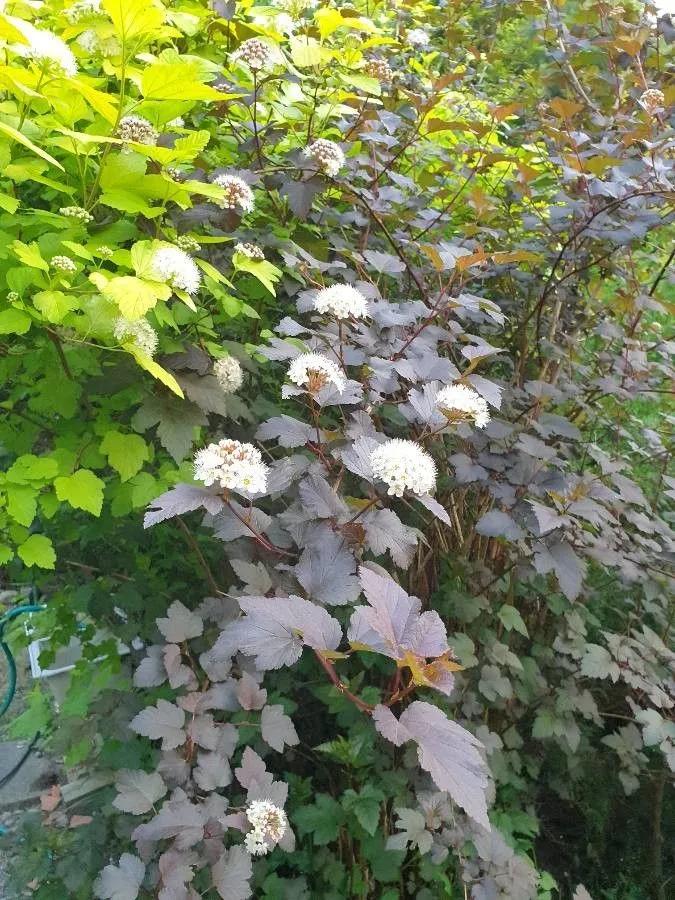
Author: (L.) Maxim.
Bibliography: Trudy Imp. S.-Peterburgsk. Bot. Sada 6: 220 (1879)
Year: 1879
Status: accepted
Rank: species
Genus: Physocarpus
Vegetable: False
Observations: E. Canada to NC. & E. U.S.A.
Ninebark, known scientifically as Physocarpus opulifolius, is a deciduous shrub belonging to the family Rosaceae. With its origins traced back to eastern Canada and the eastern United States, this versatile plant has found its niche in a variety of landscapes spanning from eastern Canada to North Carolina and throughout the eastern United States.
Recognized for its strikingly attractive appearance, Ninebark gets its name from the unique, exfoliating bark that peels away in thin layers, creating a visually captivating, multi-textured trunk that adds year-round interest. This characteristic becomes especially pronounced during the winter months when the leaves have fallen, making Ninebark a standout in the garden even in the coldest season.
In the spring and early summer, Ninebark produces an impressive display of small, white to pinkish flowers arranged in dense, spherical clusters. These blooms are not only aesthetically pleasing but also attract a variety of pollinators, contributing positively to biodiversity.
As the flowering stage concludes, the plant develops small, papery fruits that turn a vivid red-brown, adding another layer of visual appeal. The foliage, typically a vibrant green, can also present in shades of copper, bronze, or even deep purple, depending on the cultivar. This lush foliage provides a dense backdrop that enhances the garden’s texture and richness.
Ninebark is popularly used in gardening and landscaping due to its adaptability and resilience. It’s known to thrive in a wide range of soil conditions, from well-drained loams to rocky terrains, and it’s highly tolerant of drought once established. This makes it an excellent choice for low-maintenance gardens and naturalized areas.
Furthermore, it holds ecological value by providing habitat and food for wildlife. The shrub’s dense branches offer excellent nesting sites for birds, while its flowers and fruits serve as a food source for various insects and mammals.
In summary, Ninebark (Physocarpus opulifolius) is a visually appealing, ecologically valuable, and highly adaptable shrub that enriches an array of landscapes. Its year-round interest, thanks to its peeling bark, seasonal flowers, colorful fruit, and diverse foliage, makes it a treasured addition in any garden or natural area.
Dan: almindelig blærespiræa, amerikansk blærespiræa
Eng: atlantic ninebark, common ninebark, ninebark, eastern ninebark, viburnum-leaved ninebark
Deu: blasenspiere, knackbusch, schneeball-blasenspiere, schneeballblättriger spierstrauch, virginische blasenspiere
Fra: physocarpe, physocarpe à feuilles d’obier, sept écorces
Lit: putinalapis pūslenis
Ita: spirea americana
Hun: bangitalevelű hólyagvessző
Nob: blærespirea
Nno: blærespirea
Lav: irbeņlapu fizokarps
Est: lodjap-põisenelas
Fin: lännenheisiangervo
Swe: lännenheisiangervo, smällspirea
Ces: tavola kalinolistá, třavola kalinolistá
Nld: blaasjesvrucht, sneeuwbalspirea
Cym: erwain naw rhisgl
En: Ninebark, Atlantic ninebark, Common ninebark, Eastern ninebark, Viburnum-leaved ninebark, Nine Bark
Cs: Tavola kalinolistá, Třavola kalinolistá
Da: Almindelig blærespiræa, Amerikansk blærespiræa
Nl: Blaasjesvrucht, Sneeuwbalspirea
Et: Lodjap-põisenelas
Fi: Lännenheisiangervo
Fr: Physocarpe, Physocarpe à feuilles d’obier, Sept écorces
De: Schneeball-Blasenspiere, Blasenspiere, Knackbusch, Schneeballblättriger Spierstrauch, Virginische Blasenspiere, Blasenspierstrauch, Fasanenspiere
Hu: Bangitalevelű hólyagvessző
It: Spirea americana, Fisocarpo
Lv: Irbeņlapu fizokarps
Lt: Putinalapis pūslenis
Nb: Blærespirea
Nn: Blærespirea
Sv: Smällspirea, Lännenheisiangervo
Cy: Erwain Naw Rhisgl
Taken Jun 15, 2021 by Dawid Dobrowolski (cc-by-sa)
Taken May 14, 2022 by Andrzej Konstantynowicz (cc-by-sa)
Taken Oct 28, 2022 by manuseitz (cc-by-sa)
Taken Oct 2, 2022 by Andrzej Konstantynowicz (cc-by-sa)
Taken Sep 14, 2021 by Magnus Onu (cc-by-sa)
Taken Jul 1, 2022 by Richard T (cc-by-sa)
Taken May 15, 2022 by Cynthia Branscum (cc-by-sa)
Taken Jun 7, 2022 by ferdinanz (cc-by-sa)
Taken Jul 30, 2021 by Jola Jolcie (cc-by-sa)
Taken Jun 27, 2021 by Kathleen Vallée (cc-by-sa)
© copyright of the Board of Trustees of the Royal Botanic Gardens, Kew.
© copyright of the Board of Trustees of the Royal Botanic Gardens, Kew.
© copyright of the Board of Trustees of the Royal Botanic Gardens, Kew.
Taken Jul 3, 2022 by Piotr Krupski (cc-by-sa)
Taken Sep 23, 2022 by Stephanie Mckechnie (cc-by-sa)
Taken Jul 9, 2021 by Martin Hoffmann (cc-by-sa)
Taken Jul 21, 2022 by Natural Ethik (cc-by-sa)
Taken Jun 29, 2020 by Zaz Le (cc-by-sa)
Taken Oct 22, 2022 by M D (cc-by-sa)
Taken Jun 23, 2019 by mark mark (cc-by-sa)
Taken Feb 26, 2022 by Tiphus Léthal (cc-by-sa)
Taken Jun 20, 2022 by Blue Bottle (cc-by-sa)
Taken Jun 7, 2022 by Andrzej Konstantynowicz (cc-by-sa)
Taken Aug 28, 2022 by Reno Reno (cc-by-sa)
Taken Jun 11, 2020 by Erin S (cc-by-sa)
Taken Jul 6, 2021 by Robin N (cc-by-sa)
Taken Oct 10, 2019 by Jim Barnes (cc-by-sa)
Taken Jul 30, 2021 by greg plante (cc-by-sa)
Taken Jun 9, 2022 by B K (cc-by-sa)
Taken Nov 1, 2021 by B V (cc-by-sa)
Taken Sep 30, 2020 by AnnA (cc-by-sa)
Taken Nov 1, 2021 by B V (cc-by-sa)
Taken Jun 22, 2022 by Małgorzata Marczak (cc-by-sa)
Growth form: Multiple Stem
Growth habit: Shrub
Growth rate: Slow
Ph maximum: 6.5
Ph minimum: 4.5
Light: 8
Atmospheric humidity: 5
Soil nutriments: 4
Family: Myrtaceae Author: (F.Muell.) K.D.Hill & L.A.S.Johnson Bibliography: Telopea 6: 402 (1995) Year: 1995 Status:…
Family: Rubiaceae Author: Pierre ex A.Froehner Bibliography: Notizbl. Bot. Gart. Berlin-Dahlem 1: 237 (1897) Year:…
Family: Sapindaceae Author: Koidz. Bibliography: J. Coll. Sci. Imp. Univ. Tokyo 32(1): 38 (1911) Year:…
Family: Asteraceae Author: A.Gray Bibliography: Pacif. Railr. Rep.: 107 (1857) Year: 1857 Status: accepted Rank:…
Family: Fabaceae Author: Medik. Bibliography: Vorles. Churpfälz. Phys.-Ökon. Ges. 2: 398 (1787) Year: 1787 Status:…
Family: Aspleniaceae Author: (Cav.) Alston Bibliography: Bull. Misc. Inform. Kew 1932: 309 (1932) Year: 1932…